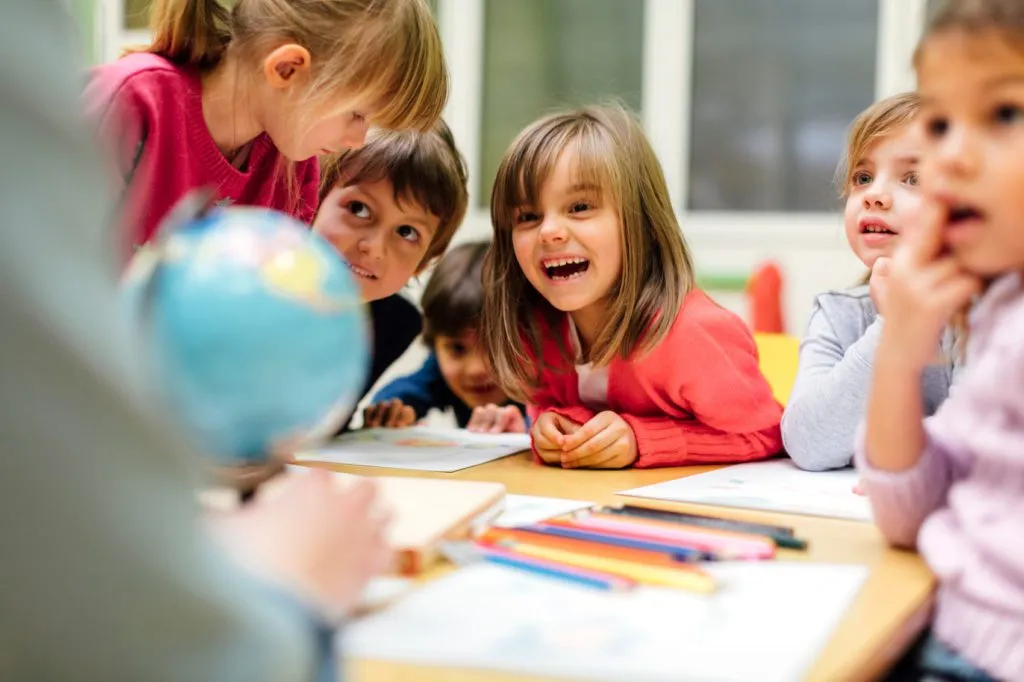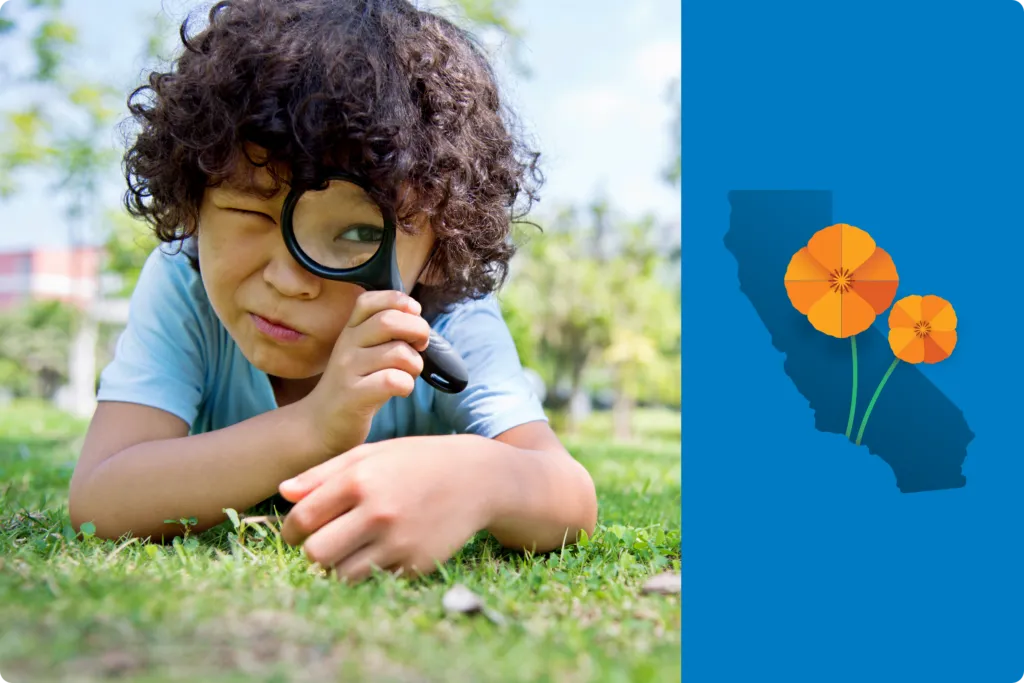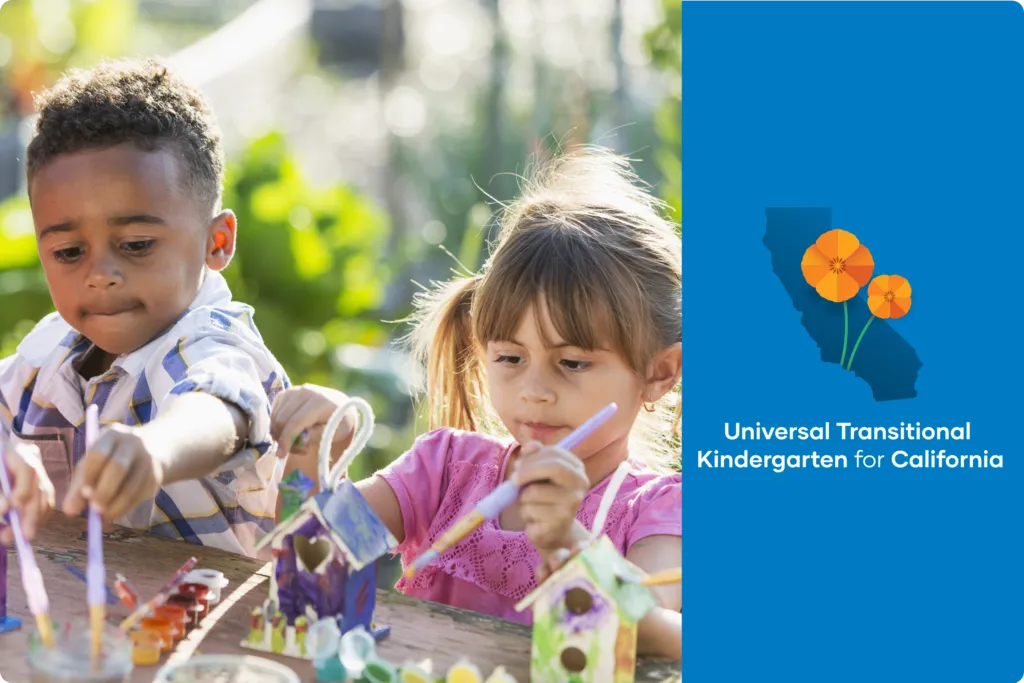What Is Transitional Kindergarten?
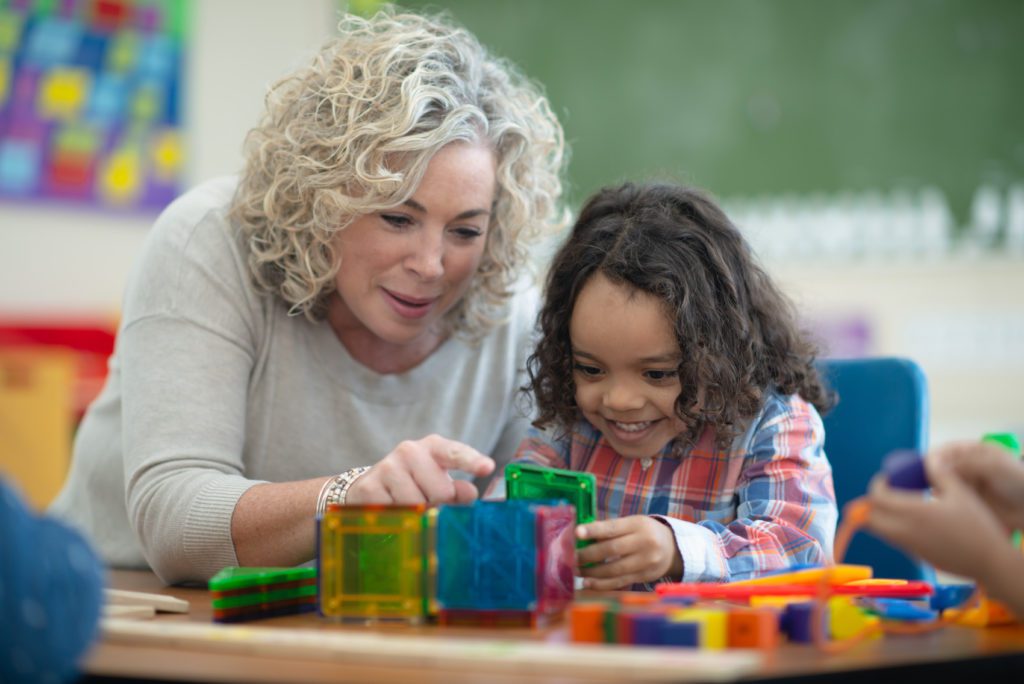
The concept of transitional kindergarten—also known as “TK”—first emerged in 2010, when California passed the Kindergarten Readiness Act. This act was created for 4-year-old children who turn 5 between September 2 and December 2, although California recently expanded the range to February 2 of the following year. Since these children have late birthdays, they traditionally missed the cutoff for kindergarten in California, which requires kindergarten students to be 5 years old by September 1.
Transitional kindergarten has recently picked up steam after California unveiled a $2.7 billion, 3-year plan to expand the offering, starting with rolling out a universal transitional kindergarten program this year.
Despite the new and exciting advancements developing in the transitional kindergarten space, many teachers, families, and school leaders have been left with unanswered questions. Fortunately, we’ve got answers.
What Is Transitional Kindergarten?
A steppingstone between preschool and kindergarten, transitional kindergarten is often referred to as the first year of a two-year kindergarten experience. It’s an entirely optional offering, since children in California are only required to start attending school once they turn 6 (although there is pending legislation that may require attending kindergarten). This means families can choose whether to enroll children in a transitional kindergarten program, sign them up for a private preschool program, or keep them home.
Transitional kindergarten programs are offered at no cost to families. Just like with kindergarten, schools can offer transitional kindergarten as a half-day (3 hours) or a full-day (6 hours) program. That said, California’s new Expanded Learning Opportunities Program requires local schools to offer a 9-hour school day that includes before- and after-school activities for transitional kindergarten through sixth grade.
Ultimately, the goal of transitional kindergarten is to provide children with late birthdays with a developmentally appropriate, play-based curriculum that will help them thrive in kindergarten. It can also help Spanish-speaking multilingual learners become more acquainted with English prior to kindergarten. This is particularly beneficial in a state with nearly 11 million Spanish speakers. In addition, since about 90% of brain growth happens before kindergarten, expanding access to early childhood education can help close the achievement gap (First Things First).1
Transitional Kindergarten vs. Preschool and Pre-K
Unlike preschool and pre-kindergarten, transitional kindergarten is part of the public school system. While families can enroll any 4-year-old child in pre-K, transitional kindergarten is currently available to children who are 4 but will turn 5 between September 2 and February 2 the following year.
Transitional kindergarten also features more structured curriculums than those used in pre-K along with modified versions of kindergarten lessons. This includes important skills for reading, writing, and math, as well as learning social–emotional skills such as listening to directions and taking turns.
Facility requirements for transitional kindergarten are the same as for kindergarten. As a result, new and existing facilities will need to ensure transitional kindergarten classrooms are close to drop-off and bus loading zones, allow for play yard supervision, include windows, provide height-appropriate sinks for children, and have restrooms located within the classroom or the kindergarten complex. To ensure providers are meeting these requirements, California has allocated about $490 million to build new transitional kindergarten facilities or update existing ones (Officer of Governor Gavin Newsom, 2021).2
Transitional Kindergarten in California
As we mentioned, California has started rolling out a universal transitional kindergarten program as part of its public school system, making it available to children regardless of family income. Although most school districts will receive funding for their transitional kindergarten programs based on the average number of children in attendance throughout the school year, approximately 15% of districts will not receive funding (Aguilera, 2022).3 Known as basic aid districts, these exempted districts are among the wealthiest in California (Aguilera, 2022).3
About 100,000 children in California attended transitional kindergarten programs in 2021 (D’Souza, 2021a).4 The new universal transitional kindergarten program has started accepting younger children and aims to ensure all 4-year-olds in California—about 400,000 children in total—are eligible for transitional kindergarten by the 2025-2026 school year (D’Souza, 2021b).5 This is a game-changing initiative for a state with almost 3 million children under the age of 5 (D’Souza, 2021b).5
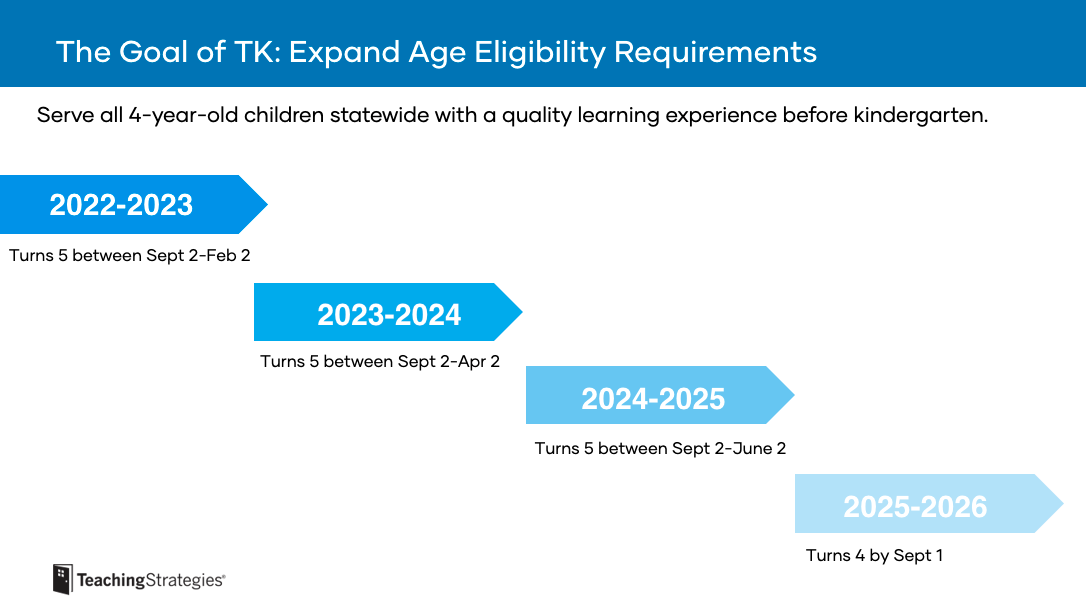
Requirements for TK teachers
Transitional kindergarten teachers are currently required to have a multiple-subject teaching credential, which is the same credential teachers need for all the elementary grades.
By 2023, transitional kindergarten teachers will also need to complete an additional 24 units of early childhood education coursework or the equivalent, depending on their employer’s requirements, or they’ll need to hold a child-development permit. To learn more about the credentialing process for transitional kindergarten teachers, check out our upcoming blog, “Preparing teachers for transitional kindergarten.”
Once transitional kindergarten teachers meet the necessary requirements, they can look forward to smaller class sizes with a ratio of 12 children per teacher or teaching assistant. California hopes to transition to 10 children per teacher by the 2025-2026 school year. Furthermore, while school districts have the final word on compensation, transitional kindergarten teachers can typically expect the same pay as kindergarten teachers.
Strengthening School-Family Connections in TK
Transitional kindergarten will mark the first time many families send their children to school, making it an ideal opportunity to start building strong family-school partnerships that can set young learners up for success.
According to the National Scientific Council on the Developing Child (2004), young children experience the world through their interpersonal relationships.6 Since these relationships affect almost all aspects of a child’s development, it’s crucial that transitional kindergarten programs nurture family engagement, such as by
- fostering an inviting, uplifting environment where families feel welcomed, regardless of whether they’re visiting their children’s classrooms or the school’s front office;
- engaging families in conversations, especially at the start of the school year, to better understand each child’s home life; and
- creating opportunities to connect with families throughout the year and maintaining an open dialogue on how families can support their children’s learning.
How Teaching Strategies Supports TK
At Teaching Strategies, we remain committed to empowering teachers and engaging children and families alike. Our transitional kindergarten curriculum is no exception. Designed to build a bridge from preschool to kindergarten, our play-based curriculum is rooted in a whole-child approach that promotes all areas of development and learning.
Explore everything Teaching Strategies offers transitional kindergarten teachers and their young learners.
Bibliography
- First Things First. (n.d.) Brain development. First Things First. https://www.firstthingsfirst.org/early-childhood-matters/brain-development/#:~:text=90%25%20of%20Brain%20Growth%20Happens%20Before%20Kindergarten&text=Incredibly%2C%20it%20doubles%20in%20size,center%20of%20the%20human%20body.
- Office of Governor Gavin Newsom. (2021, October 5). Governor Newsom signs early childhood legislation, highlights transformative investments in early learning. ca.gov. https://www.gov.ca.gov/2021/10/05/governor-newsom-signs-early-childhood-legislation-highlights-transformative-investments-in-early-learning/
- Aguilera, E. (2022, April 22). Some California school districts launch transitional kindergarten without state help. KPBS. https://www.kpbs.org/news/local/2022/04/22/some-california-school-districts-launch-transitional-kindergarten-without-state-help
- D’Souza, K. (2021a, July 12). How California’s new universal transitional kindergarten program will be rolled out. EdSource. https://edsource.org/2021/how-californias-new-universal-transitional-kindergarten-program-will-be-rolled-out/657818
- D’Souza, K (2021b, October 13). Universal transitional kindergarten: Quick guide. EdSource. https://edsource.org/2021/universal-transitional-kindergarten-quick-guide/662318
- National Scientific Council on the Developing Child. (2004). Young children develop in an environment of relationships: Working paper No. 1. Center on the Developing Child, Harvard University. https://developingchild.harvard.edu/resources/wp1/
